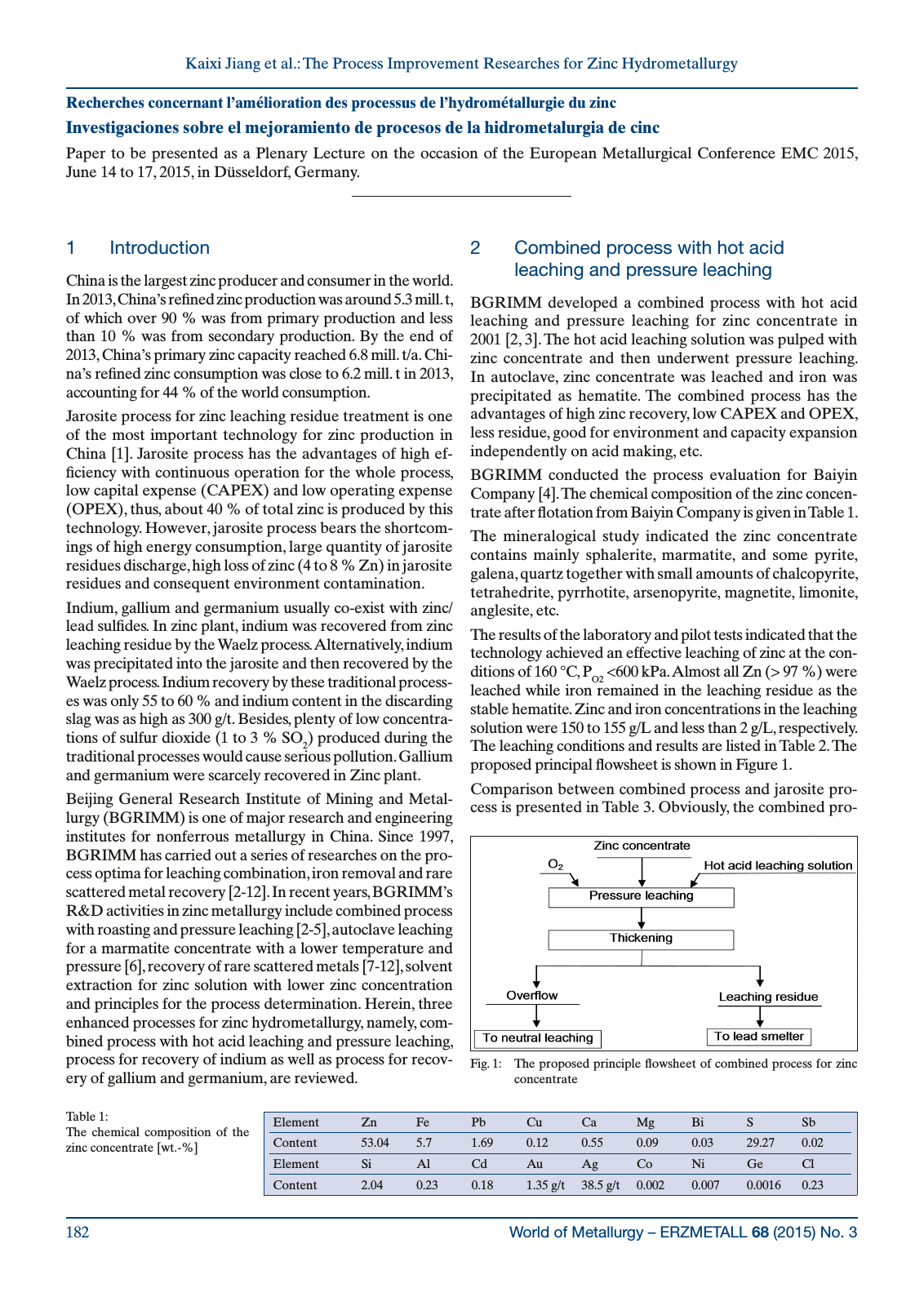World of Metallurgy ERZMETALL 68 2015 No 3182 Kaixi Jiang et al The Process Improvement Researches for Zinc Hydrometallurgy Recherches concernant l amélioration des processus de l hydrométallurgie du zinc Investigaciones sobre el mejoramiento de procesos de la hidrometalurgia de cinc Paper to be presented as a Plenary Lecture on the occasion of the European Metallurgical Conference EMC 2015 June 14 to 17 2015 in Düsseldorf Germany 1 Introduction China is the largest zinc producer and consumer in the world In 2013 China s refined zinc production was around 5 3 mill t of which over 90 was from primary production and less than 10 was from secondary production By the end of 2013 China s primary zinc capacity reached 6 8 mill t a Chi na s refined zinc consumption was close to 6 2 mill t in 2013 accounting for 44 of the world consumption Jarosite process for zinc leaching residue treatment is one of the most important technology for zinc production in China 1 Jarosite process has the advantages of high ef ficiency with continuous operation for the whole process low capital expense CAPEX and low operating expense OPEX thus about 40 of total zinc is produced by this technology However jarosite process bears the shortcom ings of high energy consumption large quantity of jarosite residues discharge high loss of zinc 4 to 8 Zn in jarosite residues and consequent environment contamination Indium gallium and germanium usually co exist with zinc lead sulfides In zinc plant indium was recovered from zinc leaching residue by the Waelz process Alternatively indium was precipitated into the jarosite and then recovered by the Waelz process Indium recovery by these traditional process es was only 55 to 60 and indium content in the discarding slag was as high as 300 g t Besides plenty of low concentra tions of sulfur dioxide 1 to 3 SO2 produced during the traditional processes would cause serious pollution Gallium and germanium were scarcely recovered in Zinc plant Beijing General Research Institute of Mining and Metal lurgy BGRIMM is one of major research and engineering institutes for nonferrous metallurgy in China Since 1997 BGRIMM has carried out a series of researches on the pro cess optima for leaching combination iron removal and rare scattered metal recovery 2 12 In recent years BGRIMM s R D activities in zinc metallurgy include combined process with roasting and pressure leaching 2 5 autoclave leaching for a marmatite concentrate with a lower temperature and pressure 6 recovery of rare scattered metals 7 12 solvent extraction for zinc solution with lower zinc concentration and principles for the process determination Herein three enhanced processes for zinc hydrometallurgy namely com bined process with hot acid leaching and pressure leaching process for recovery of indium as well as process for recov ery of gallium and germanium are reviewed 2 Combined process with hot acid leaching and pressure leaching BGRIMM developed a combined process with hot acid leaching and pressure leaching for zinc concentrate in 2001 2 3 The hot acid leaching solution was pulped with zinc concentrate and then underwent pressure leaching In autoclave zinc concentrate was leached and iron was precipitated as hematite The combined process has the advantages of high zinc recovery low CAPEX and OPEX less residue good for environment and capacity expansion independently on acid making etc BGRIMM conducted the process evaluation for Baiyin Company 4 The chemical composition of the zinc concen trate after flotation from Baiyin Company is given in Table 1 The mineralogical study indicated the zinc concentrate contains mainly sphalerite marmatite and some pyrite galena quartz together with small amounts of chalcopyrite tetrahedrite pyrrhotite arsenopyrite magnetite limonite anglesite etc The results of the laboratory and pilot tests indicated that the technology achieved an effective leaching of zinc at the con ditions of 160 C PO2 600 kPa Almost all Zn 97 were leached while iron remained in the leaching residue as the stable hematite Zinc and iron concentrations in the leaching solution were 150 to 155 g L and less than 2 g L respectively The leaching conditions and results are listed in Table 2 The proposed principal flowsheet is shown in Figure 1 Comparison between combined process and jarosite pro cess is presented in Table 3 Obviously the combined pro Table 1 The chemical composition of the zinc concentrate wt Element Zn Fe Pb Cu Ca Mg Bi S Sb Content 53 04 5 7 1 69 0 12 0 55 0 09 0 03 29 27 0 02 Element Si Al Cd Au Ag Co Ni Ge Cl Content 2 04 0 23 0 18 1 35 g t 38 5 g t 0 002 0 007 0 0016 0 23 Fig 1 The proposed principle flowsheet of combined process for zinc concentrate

Hinweis: Dies ist eine maschinenlesbare No-Flash Ansicht.
Klicken Sie hier um zur Online-Version zu gelangen.
Klicken Sie hier um zur Online-Version zu gelangen.